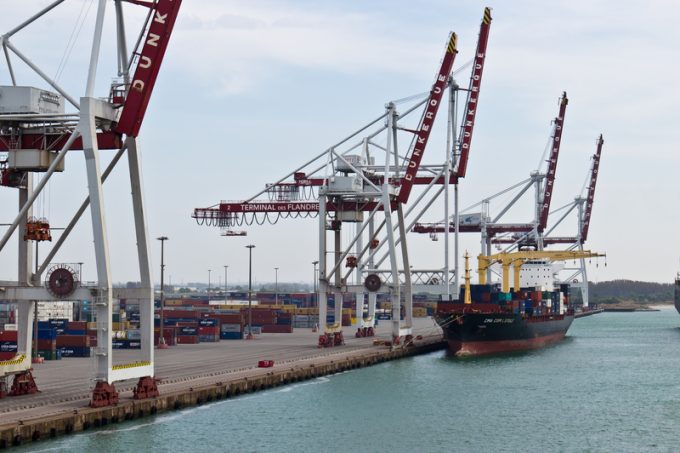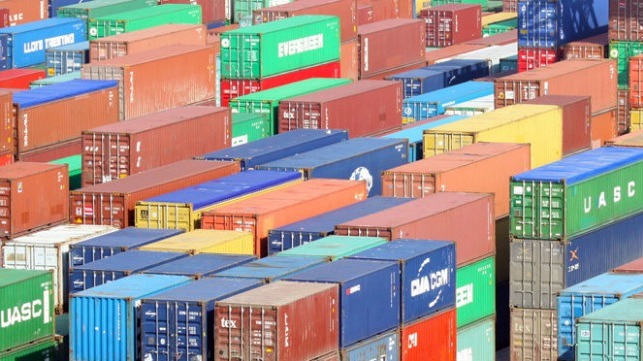Welcome to GLA! Leading the global logistics alliance.


Your location:Home > News > CHINESE PORTS CONTINUE TO BREAK THROUGHPUT RECOURDS.HAS INTERNATIONAL TRADE FULLY RECOVERED?
Time:2020-12-21 Publisher:Bridge Num:6873
"Yantian Port processes a TEU in an average of 2.4 seconds, and one ship departs to the United States every 4 hours. This year, the port throughput will set a record for the port in the past 20 years." said Lin Qingwen, Managing Director of Yantian International Container Terminal Co., Ltd. One out of every four containers imported by the United States from China comes from Yantian Port in Shenzhen, which has set a global single terminal throughput record for two consecutive months this year.
As the world's largest container port, Shanghai Port also set a monthly historical record of container throughput in July and October this year. According to data released by the China Ports Association, in October, the container throughput of China's eight major hub ports increased by 11.1% year-on-year, and the growth rate hit a new high this year.

At the same time, an unprecedented "container shortage" is sweeping across the country and has become a "urgency" for foreign traders. Behind this, whether China's foreign trade has fully recovered.
From the macro data, the answer seems to be yes. According to data released by the General Administration of Customs on December 7, China's foreign trade imports and exports in November were US$460.72 billion, an increase of 13.6%. Among them, exports were US$268.07 billion, an increase of 21.1%; imports were US$192.65 billion, an increase of 4.5%. The total value of imports and exports in November and the value of exports both set a single-month record since the statistics were available in 1979. Excluding seasonal factors, the growth rate of exports in November also set a new high in the past nine years. The scale of China's imports and exports in the first 11 months also hit a record high over the same period in history.
This greatly exceeded expectations at the beginning of the year. At that time, due to the impact of the epidemic, a large number of orders were cancelled, and the foreign trade market was full of grief. However, after entering the second half of the year, the plot quickly reversed: a large number of foreign trade factory orders surged, and news of exploding orders, exploding cabins, lack of cabinets, overtime, and enrollment expansion was endless.
This is because the economic recovery of various countries in the epidemic is not synchronized: China has quickly resumed work and production after controlling the epidemic, while the epidemic in many other countries has continued to repeat, and there have been signs of accelerated rebound in recent days, and factories in some countries have been forced to stop production. The production chain has broken, the market supply of these countries can only be solved through imports, and the dependence of the international market on Chinese trade has increased.
In this process, the global manufacturing industry has a tendency to return to China. For example, some foreign trade orders from countries such as India, Bangladesh, and Vietnam are being transferred to China. On the other hand, since the epidemic, various countries have taken different measures to stimulate the economy: Europe and the United States have focused more on stimulating the consumer side, while China has paid more attention to the resumption of work and production on the supply side and the integrity of the industrial chain.
Therefore, during the epidemic, the income level of consumers in European and American countries has not dropped significantly. Affected by the epidemic, although overseas consumers have significantly reduced their consumption of services such as tourism, they have increased the renovation of houses, replacement of furniture, home appliances and other physical objects consumption.
Correspondingly, China's exports of building materials, furniture and home appliances have grown rapidly recently. As the first country to survive the epidemic and resume normal production, China quickly responded to overseas consumer demand with its complete domestic supply chain and huge manufacturing scale, which brought a surge in exports.
In addition, the recent historical record of foreign trade exports also has traditional seasonal factors. Near Christmas and New Year, foreign centralized purchases need to be stocked in advance. This is the peak season for Chinese exports, and this year is no exception. It is worth noting that the epidemic is profoundly reconstructing the product structure and trade mode structure of China's foreign trade.
As Bai Ming, deputy director of the International Market Research Institute of the Ministry of Commerce, said the recovery of China's foreign trade after the epidemic is not the overall recovery of the entire industry, but there is obvious industrial differentiation. Among them, the export of anti-epidemic materials such as masks and ventilators, household products such as furniture and home appliances, fitness equipment, and electronic products related to online transformation performed the most strongly.

According to statistics from the General Administration of Customs, in the first three quarters of this year, China exported 880.8 billion yuan of "home economy" commodities such as notebook computers, tablet computers, and home appliances, an increase of 17.8%, driving an export growth of 1.1%. China’s exports of textiles, medical equipment, and medicines, including masks, totaled 1.04 trillion yuan, an increase of 36.5%, driving an export increase of 2.2%.
According to Helen Feng, the business director of Dongguan Jiamu Packaging Materials Co., Ltd., due to the closure of a large number of restaurants, the company that uses packaging boxes as its main export product suffered a serious setback before April, but the company quickly adjusted its production line and changed its production protection. Face masks, the latter accounted for 40% of its total exports.
"This year, our foreign trade should be able to reach 80 to 90 million yuan and achieve positive growth, but if we do not export epidemic prevention materials, our traditional business may experience a sharp decline." Helen Feng pointed out that after the outbreak, the foreign trade industry is very divided. obvious. "In Dongguan, factories that used to make clothing, shoes, women's bags and other industries are basically closed now; however, factory orders for epidemic prevention materials, furniture, bicycles, and 3D printers have skyrocketed. Schedule is very busy."
Xie Hua, the person in charge of Zhangjiagang Keen Machinery Co., Ltd., feels the same. She said that the export orders of many furniture, home appliances and daily necessities in the Yangtze River Delta have grown rapidly, but the company that she works for has plastic extruders as its main products. The foreign trade orders are less than half of previous years.
She believes that this is because the epidemic has interrupted the traditional trade process. For example, in the machinery industry, overseas customers need to go to the site to see the equipment before placing orders. This year, customers will not be able to make it, and orders will naturally decline. "Products such as daily necessities do not require on-site inspections. Many only need a sample, and even transactions can be completed online."
The epidemic has also accelerated the migration of China's international trade online. Under the epidemic, China's two consecutive Canton Fairs have been held online, and whether it is B2B or B2C, multiple cross-border e-commerce platforms have doubled. Wang Donghua, sales manager of New Camry (Zhangzhou) Commodity Co., Ltd., believes that an important reason for the intensified "container shortage" is the surge in e-commerce exports. She pointed out that traditional export logistics demand is basically stable, and the biggest variable is e-commerce exports. "This year a large number of factories have switched to online, which has brought a great market increase. In previous years, factories that could receive 100,000 orders were transferred to It is very likely that 200,000 orders have been received online. Now our company's e-commerce orders account for nearly 80% of the total international trade orders. Online orders are much more than expected, but the cabinets on the market have not prepared so many."
The "container shortage" will eventually pass, and a question facing China's foreign trade is how long can such a boom last? In the short term, the current overseas consumer goods inventory is still low, and the contradiction of insufficient foreign production capacity is still prominent. Due to the base problem, the high speed the growth of China's foreign trade is expected to continue to advance by leaps and bounds, and is likely to set a higher growth rate in the first quarter of next year.
In the medium and long term, China's foreign trade will eventually return to a normal range. The future foreign trade prosperity depends on the strength of external demand, on the one hand, foreign currency tightness, employment income and other factors are crucial; on the other hand, it depends on the recovery of the global industrial chain, no matter from which way it is still spreading The epidemic is the biggest uncertainty.
For China, the reversal and expansion of foreign trade this year is neither expected earlier nor the result of active pursuit. China has not set a specific growth target for foreign trade for many years, and replaced it with the requirement of "improving quality and efficiency", which is still a long way to go.
2019 the 7th GLA Panel Discussion Wonderful Review
Prev:GLA MEMBERSHIP RENEWAL| MEO INTERNATIONAL LOGISTICS INDIA PVT LTD from INDIANext:GLA MEMBERSHIP RENEWAL| FLAMEKO FORWARDING from ESTONIA
Recommended Membership
Latest News